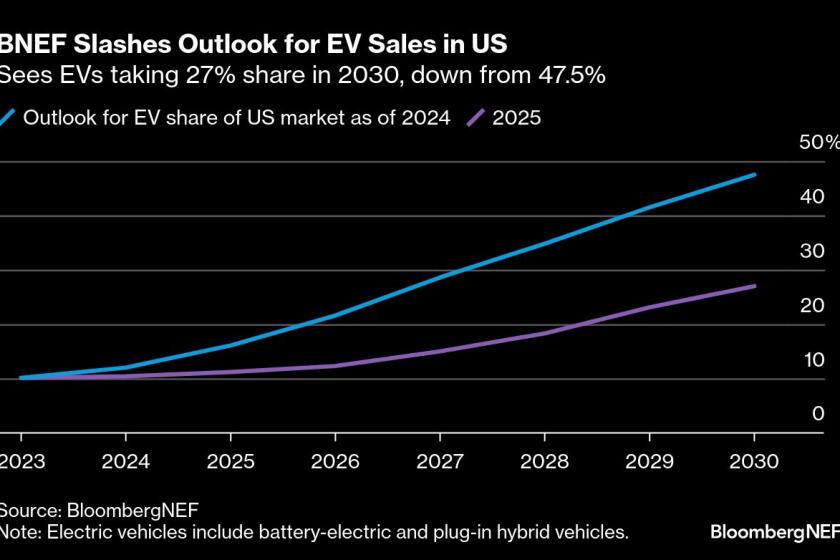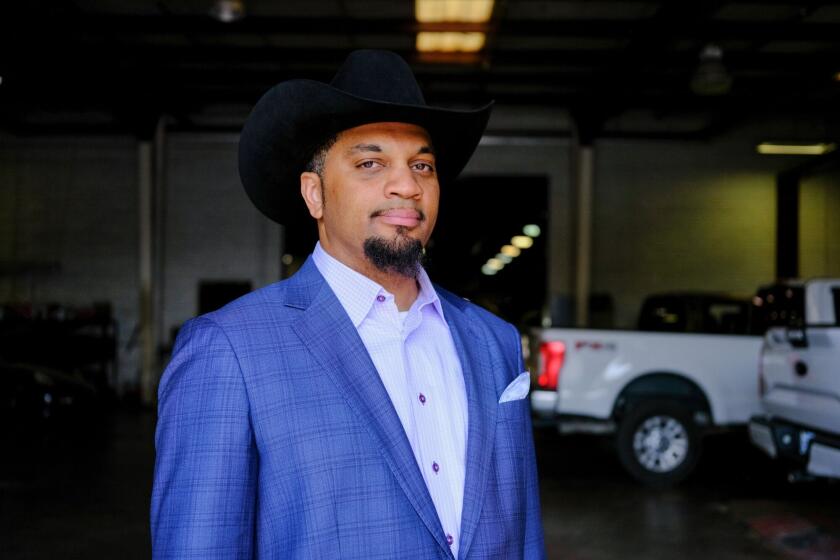Battery Technology Fuels the Electric Vehicle Debate : Business: Manufacturers say they need mandate to attract investors. Air resources board decides this week.
- Share via
AUSTIN, Tex. — Deep in the heart of Texas, where oil is king, a little company is developing an advanced battery for electric vehicles that it hopes will leave gas guzzlers on the roadside like so many dead armadillos.
After more than a decade of research and development, Electrosource Inc. is nearing completion of a pilot plant--the first of its kind--that the company hopes will prove its advanced lead-acid batteries can affordably be mass-produced within two years.
California is counting on Electrosource and other battery developers to succeed. Their progress will be center stage in Los Angeles on Thursday and Friday, when the California Air Resources Board decides whether to uphold its mandate requiring major auto makers to produce zero-emission vehicles--electrics now being the only option--for sale beginning in 1998.
The decision is a watershed in determining whether Californians--and residents of the heavily populated Northeast states that are following Sacramento’s lead--will have a new vehicle choice in less than four years.
“This is the biggest issue facing the auto industry today,” said Richard Klimisch, vice president of the American Automobile Manufacturers Assn., the Big Three’s lobbying group.
Auto makers and the oil industry oppose the mandate, which requires 2% of vehicles--about 25,000 cars--offered for sale in California to be zero-emission in 1998, rising to 5% in 2001 and 10% in 2003. Electric utilities, environmentalists and others want to stay the course.
The political stakes are high. The auto makers have taken their case to Gov. Pete Wilson, and lobbying on all sides has intensified in the days leading up to the hearings. Seven of 11 board members have been appointed since the last review two years ago, including ARB Chairwoman Jacqueline Schafer, lending an element of uncertainty to the decision.
But for all the high-powered politics, the debate largely revolves around one issue: battery technology.
There are few clear answers. Strides have been made in just a few years of aggressive research. But whether batteries with adequate power, energy and durability can be mass-produced for 1998 is hotly debated.
The auto industry says it cannot be done. If the mandate stands, car makers say, they will be forced to spend hundreds of millions of dollars to build vehicles that consumers won’t want.
But the ARB’s staff contends that a variety of good batteries--not only advanced versions of the lead-acid ones used in cars today, but also nickel-metal hydride, nickel-sodium-chloride and sodium-sulfur units--should be at the auto makers’ disposal by 1998. Vehicles with these batteries can go far enough for most daily uses and cost the same to operate as gasoline-powered cars, the staff contends.
Just as important, electric vehicle proponents argue that the zero-emission rules must be maintained to keep forcing the technological development of electric vehicles and to attract venture capital to the effort.
“Potential investors are sitting on the sidelines waiting to see what happens,” said Richard Schweinberg, manager of transportation research for Southern California Edison Co. “If the mandate is delayed, the money will dry up.”
Electrosource, one of scores of firms racing to bring better batteries to market, is a front-runner in the commercialization of advanced lead-acid batteries. But its history is as full of ups and downs as the nearby Texas hill country. Just three years ago, the company ran out of cash and temporarily stopped operations. It has never made money and is in constant search of investors and partners.
Nonetheless, Electrosource officials remain effervescent about the company’s prospects. “If the market develops, I guarantee we will be a major player,” said President Benny Jay, a former defense industry executive turned entrepreneur.
Such optimism is not unusual among small companies seeking a niche in the fledgling electric vehicle market, where claims of technological breakthroughs are thrown around like confetti at a Texas high school football game.
Electrosource and its backers acknowledge that its technology still must be proved through rigorous testing. The company also must show that the battery can be affordably manufactured.
“We are close,” said Jack Guy, manager of commercialization for the Electric Power Research Institute, a nonprofit utility group that provides funding to Electrosource. “It’s a slow process, but it is doable.”
That process began in the early 1980s at Tracor Inc., an Austin-based defense contractor, where researchers working with composite materials developed a new process to bond lead onto fiberglass thread. Seeking to commercialize the discovery, Tracor in 1987 formed a public company, Electrosource, which soon said it had found a way to enhance the life, energy and power of lead-acid batteries.
The technology drew attention after California adopted its zero-emission mandate in 1990. Electrosource teamed up with General Motors, which was searching for better batteries for its Impact, an electric two-seater. But GM, with its financial problems mounting, backed out of the project in 1991, and Electrosource--with losses mounting--closed its doors that September. It was not until early 1992 that the company resumed operations, with new money from an investment group headed by Jay.
About this time, the U.S. Advanced Battery Consortium--a partnership of U.S. auto makers, electric utilities and the federal government--was formed to speed up development of better batteries. The consortium decided not to put any of its $262-million research kitty into advanced lead-acid batteries, figuring little could be gained from further development of a century-old technology.
Although a federal research consortium declined to invest in lead-acid batteries, EPRI concluded that Electrosource’s product could help jump-start the electric vehicle market. In mid-1992, it gave Electrosource $5 million, an infusion that allowed the company to begin building 12-volt batteries and testing their performance.
“Electrosource is the best bet we have for 1998,” said Guy, who oversees the institute’s project with the company.
The Electrosource battery differs from traditional lead-acid units in several ways. Instead of heavy lead plates, it uses a lightweight lead thread woven into mesh grids. These are arranged in a horizontal pattern rather than the normal vertical design, which the company says makes the battery stronger and lengthens its life. Because the battery is not flooded with sulfuric acid, it is also lighter.
Electrosource says the recyclable, maintenance-free battery can be recharged 50% in nine minutes and fully charged in 30 minutes. It can withstand 900 charge cycles, enough to last for 80,000 miles, according to the firm. For an Impact-type car, it can provide up to 140 miles per charge, the firm says; for a minivan, about 80 miles. Battery packs are expected to cost $2,000 to $3,000.
Proponents--citing studies that show average round-trip commutes are less than 35 miles--argue that there is a market for electric vehicles with such batteries. But auto company officials say their studies show that even customers predisposed to electric vehicles would not buy them without a range of 125 miles--50 for regular daily needs, 50 for emergencies and 25 as a cushion to run the heater or air conditioning.
“Telling customers, ‘I don’t care what you want, you only need 50 miles of range,’ sounds to me like a recipe for disaster,” said John Wallace, acting head of Ford’s electric vehicle program.
Now, Electrosource is putting its batteries through rigorous laboratory tests. And in a joint venture with BDM Technologies, a McLean, Va., builder of manufacturing systems, it is gearing up battery production at a pilot plant in San Marcos, 30 miles south of Austin.
The plant’s makeshift production line--a series of work cells with employees carrying parts from one machining area to the next--now ekes out about five batteries a day.
When completed, the system will be fully automated. Jay said the company hopes to be producing 500 batteries a month by the end of this year and more than 4,000 a month by the second half of 1995. A fully operational manufacturing plant, which will cost about $30 million, could be in operation by 1996--if funding is forthcoming, he said.
But the company has missed deadlines before. Chrysler and Ford have been clamoring for Electrosource batteries for months. The pilot plant is at least a month behind schedule, a delay Electrosource blames on suppliers.
Such lags concern auto makers, which soon must make crucial decision on batteries if they are to meet the 1998 mandate. The industry says it will be difficult to put sizable electric vehicle fleets on California roads before 2000, given the need to test batteries, set up pilot plants and build full-scale manufacturing plants.
So Detroit wants the mandate delayed. But battery developers say that would be their death knell. Given the difficulty of raising money for risky ventures, further advances will be nearly impossible unless California sticks to its guns, they say.
Donald Orr, manager of Electrosource’s pilot plant, said: “Nobody is going to build a battery plant unless there is a mandate.”






